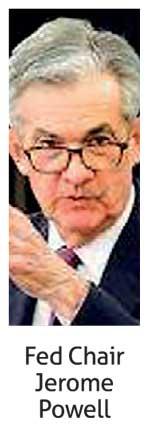18 Mar 2022 - {{hitsCtrl.values.hits}}
REUTERS: The Federal Reserve this week raised interest rates for the first time since 2018 and laid out an aggressive plan to push borrowing costs to restrictive levels next year in a pivot from battling the coronavirus pandemic to countering the economic risks posed by excessive inflation and the war in Ukraine.
 The U.S. central bank’s Federal Open Market Committee kicked off the move to tighten monetary policy with a quarter-percentage-point increase in the target federal funds rate, lifting that key benchmark from the current near-zero level in a step that will ripple through a variety of other rates charged to consumers and businesses.
The U.S. central bank’s Federal Open Market Committee kicked off the move to tighten monetary policy with a quarter-percentage-point increase in the target federal funds rate, lifting that key benchmark from the current near-zero level in a step that will ripple through a variety of other rates charged to consumers and businesses.
But more notably, new Fed projections showed policymakers ready to shift their inflation fight into high gear, with one policymaker, St. Louis Fed President James Bullard, dissenting in favour of an even more aggressive approach.
Most policymakers now see the federal funds rate rising to a range between 1.75 percent and 2 percent by the end of 2022, the equivalent of a quarter-percentage-point rate increase at each of the Fed’s six remaining policy meetings this year.
They project it will climb to 2.8 percent next year - above the 2.4 percent level that officials now feel would work to slow the economy.
Fed Chair Jerome Powell, speaking after the end of the latest two-day policy meeting, said the economy is strong enough to weather the rate hikes and maintain its current strong hiring and wage growth, and that the Fed needed to now focus on limiting the impact of price increases on
American families.
Even with Wednesday’s actions, inflation is expected to remain above the Fed’s 2 percent target through 2024, and Powell said officials would not shy from raising rates more aggressively if they don’t see improvement.
“The way we’re thinking about this is that every meeting is a live meeting” for a rate hike, Powell said in a news conference, emphasizing that the Fed could add the equivalent of more rate increases by also paring its massive bond holdings. “We’re going to be looking at evolving conditions, and if we do conclude that it would be appropriate to move more quickly to remove accommodation, then we’ll do so.”
Rate increases work to slow inflation by curbing demand for big-ticket items like houses, automobiles or home improvement projects that become more expensive to finance, which can also slow economic growth and potentially
increase unemployment.
The economy may already be slowing for other reasons. Fed policymakers marked down their gross domestic product growth estimate for 2022 to 2.8 percent, from the 4 percent projected in December, as they began to analyze the new risks facing
the global economy.
“That is just an early assessment of the effects of spillovers from the war in Eastern Europe, which will hit our economy through a number of channels,” Powell said. “You are looking at higher oil prices, higher commodity prices. That will weigh on GDP to some extent.”
Over time, Fed policy itself would begin curbing economic activity, Powell said.
“The Fed is playing catch-up and clearly recognizes the need to get back in front of the inflation situation,” said Seema Shah, chief strategist with Principal Global Investors.
“It won’t be easy - rarely has the Fed safely landed the U.S. economy from such inflation heights without triggering an economic crash. Furthermore, the conflict ... has the potential to disrupt the Fed’s path. But for now, the Fed’s priority has to be price stability.”
The Fed’s preferred measure of inflation is currently increasing at a 6 percent annual rate.
15 Nov 2024 23 minute ago
15 Nov 2024 2 hours ago
15 Nov 2024 2 hours ago
15 Nov 2024 3 hours ago
15 Nov 2024 3 hours ago